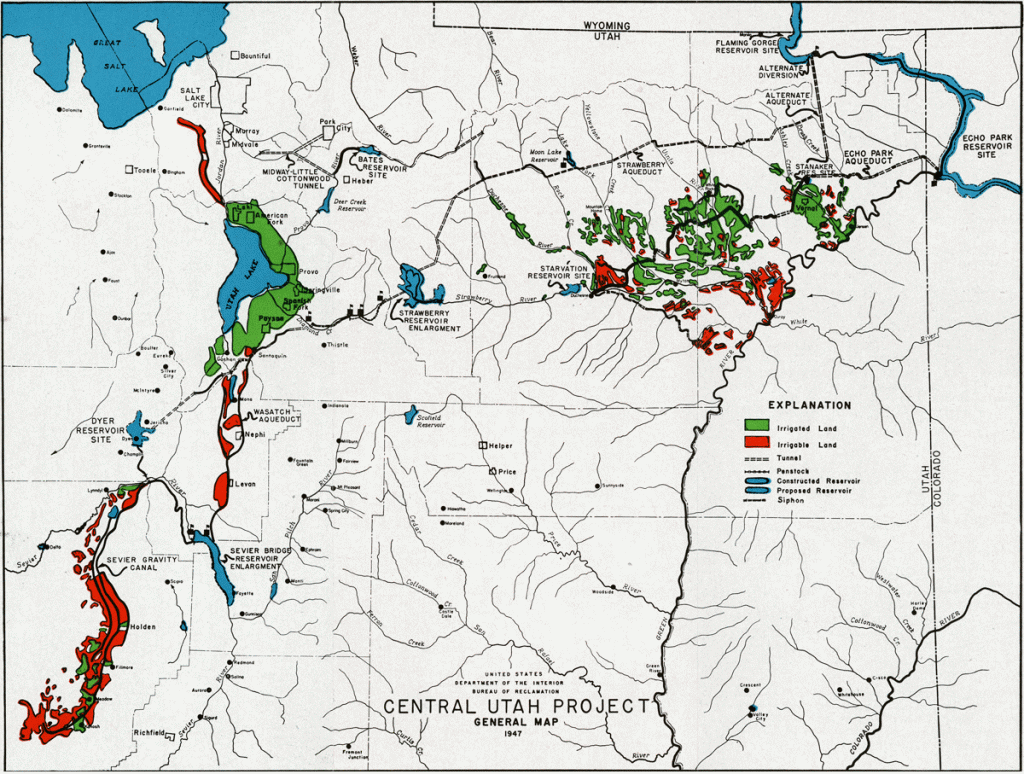In 1939, the Bureau of Reclamation (BoR) proposed delivery of one million acre-feet of water annually from the Green River in eastern Utah to the Great Basin and the most highly developed part of the state along the Wasatch Front. The Central Utah Project (CUP) is the largest and most complex water resources development program ever undertaken by the BoR in the state of Utah. Given the amount of water the project was originally intended to deliver, the initial plans for the CUP were among the most intricate ever submitted to the Bureau of Reclamation.
The Central Utah Project would provide Utah with the opportunity to beneficially use a sizable portion of its allotted share of the Colorado River water. CUP water was to be used for municipal, industrial, irrigation, hydroelectric power, fish, wildlife, conservation, and recreation. The project was also intended to improve flood control capability and assist in water quality control.
In a study prepared for Congress by the Bureau of Reclamation, the mining division of the U. S. Bureau of Mines proposed a 20.1-mile Park City—Alta drainage tunnel as a part of the CUP. The tunnel would be Y-shaped with one end beginning near Midway, Wasatch County and the other near Park City. The two branches would connect near Alta and the tunnel would continue to a main portal in Little Cottonwood Canyon.

Credit: Courtesy of the Utah State Archives and Records Service, Governor Clyde Upper Colorado River project case files, Series 200
In terms of mining, a 1949 report compiled by Paul T. Allsman, chief, and M. E. Volin, assistant chief, Salt Lake branch of the mining division stated that many hundreds of millions of dollars of watered ore would be freed in the Park City District, should the project be undertaken. It was thought that the tunnel would lower the water level in the district by more than 1,000 feet, freeing a predicted 6,500,000 tons of ore. Mr. Allsman valued the ores freed by the drainage tunnel, including gold, silver, lead and zinc, at more than $550,000,000.
Salt Lake City winter sports enthusiasts saw construction of the tunnel as a solution to the sanitation problems at Alta and Brighton. These sportsmen foresaw use of the tunnel as a sewage canal in connection with a filtration plant to be built in the valley by Salt Lake City.
The proposed drainage tunnel, Mr. Allsman said, would function entirely as a gravity flow drain and after construction would require little maintenance. Water drained from the area would pour into the Salt Lake Valley where it would be available for culinary purposes.
It was estimated that the tunnel might cost $40,000,000 and take ten years to complete. Bureau of Mines officials stated that the drainage tunnel might be undertaken “in the interest of our national welfare.” The necessity of prolonging the life of the state’s greatest lead-zinc-silver mining area was of vital importance to America’s national defense they felt.
The Park City-Little Cottonwood tunnel was not part of the CUP when it was officially authorized by Congress for construction in 1956 under provisions of the Colorado River Storage Project Act. The tunnel idea was lost, but not forgotten as we shall see in our next installment.